HUMMINGBIRD COLLEGE:
THE "KEYSTONE 12" IN BELIZE
At Hilton Pond Center we--and other researchers elsewhere in the U.S. and Canada--capture lots of Ruby-throated Hummingbirds each year, but in a century of North American hummer banding none of those migrant birds has ever been reported from "south of the border." Thus, since 2004 we've led citizen science expeditions to Central America as part of Operation RubyThroat's on-going efforts to find out specifically where southbound ruby-throats hang out during winter and--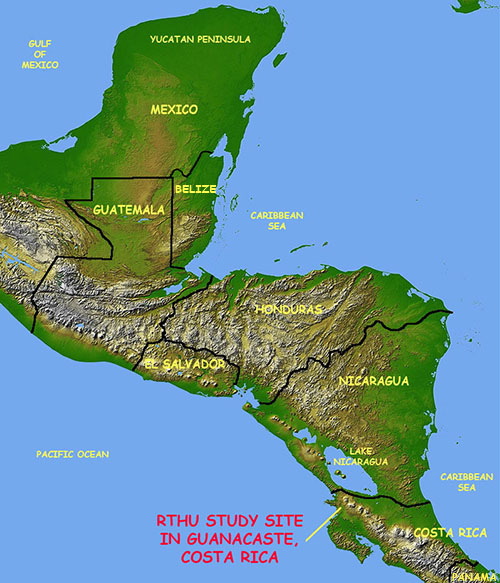 since we've banded nearly a thousand RTHU "down there" in the Neotropics--where those wintering birds return each spring. With 16 Neotropical trips completed, we hope odds are increasing a bander eventually will catch one of these tiny long-distance migrants we've marked and unveil one of the big secrets of bird migration. So far just one of our RTHU from Guanacaste Province in western Costa Rica (see map above left) has been encountered again in North America--a female found one spring six months after banding at Baxley GA west of Savannah. This is the ONLY hummingbird of any species ever encountered a continent away from its banding site. In March 2010 we expanded our Neotropical research destinations by adding Belize on the Caribbean side of the Yucatan Peninsula and banded 54 ruby-throats. A follow-up visit last year yielded just 18 birds, so in 2012 we were eager to get back to Belize to study and band more of that country's RTHU. since we've banded nearly a thousand RTHU "down there" in the Neotropics--where those wintering birds return each spring. With 16 Neotropical trips completed, we hope odds are increasing a bander eventually will catch one of these tiny long-distance migrants we've marked and unveil one of the big secrets of bird migration. So far just one of our RTHU from Guanacaste Province in western Costa Rica (see map above left) has been encountered again in North America--a female found one spring six months after banding at Baxley GA west of Savannah. This is the ONLY hummingbird of any species ever encountered a continent away from its banding site. In March 2010 we expanded our Neotropical research destinations by adding Belize on the Caribbean side of the Yucatan Peninsula and banded 54 ruby-throats. A follow-up visit last year yielded just 18 birds, so in 2012 we were eager to get back to Belize to study and band more of that country's RTHU.
Thanks to efforts by biology professor Dr. Jerry Skinner, this year's Belize expedition became reality but was unlike any we had undertaken to date: Participants were undergraduate students from Keystone College in north central Pennsylvania--a much younger group than our usual mix of adults citizen scientists.  Jerry had heard our hummingbird paper presentation in 2009 at a joint meeting in Pittsburgh of the Wilson Ornithological Society and Association of Field Ornithologists and was intrigued by the prospect of involving his undergrads in our field work. Using his powers of persuasion, Jerry recruited ten students, a staff member, and himself as a group we decided to call the "Keystone 12" and prepared them to gather in Belize. In advance of the trip we held a Hilton Pond-to-Keystone Web conference so everyone could meet virtually and ask questions--a useful technological preface to our pending backcountry hummingbird expedition. Trip timing was dictated by Keystone's spring break during the second full week of March 2012--more than a week later than we conducted Belizean field work in 2010 and 2011--so we weren't sure how many ruby-throats we would encounter. Jerry had heard our hummingbird paper presentation in 2009 at a joint meeting in Pittsburgh of the Wilson Ornithological Society and Association of Field Ornithologists and was intrigued by the prospect of involving his undergrads in our field work. Using his powers of persuasion, Jerry recruited ten students, a staff member, and himself as a group we decided to call the "Keystone 12" and prepared them to gather in Belize. In advance of the trip we held a Hilton Pond-to-Keystone Web conference so everyone could meet virtually and ask questions--a useful technological preface to our pending backcountry hummingbird expedition. Trip timing was dictated by Keystone's spring break during the second full week of March 2012--more than a week later than we conducted Belizean field work in 2010 and 2011--so we weren't sure how many ruby-throats we would encounter.
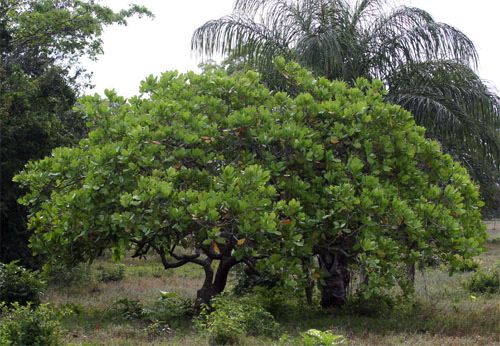
All text, tables, maps, charts & photos © Hilton Pond Center
Thanks to a tip from British bander Nick Bayly--we learned several years ago that Ruby-throated Hummingbirds congregate each spring in Belize on Crooked Tree Island, about an hour west of and inland from coastal Belize City. The hummers apparently are attracted to nectar-rich blossoms of the Cashew, Anacardium occidentale (above), a Brazilian native tree planted in the mid-18th century as a cash crop by entrepreneurs from Britain. (Belize is the former colony of British Honduras and the only Latin American country with English as its official language.)

All text, tables, maps, charts & photos © Hilton Pond Center
Cashew's tiny white and purple Cashews flowers (above) appear at Crooked Tree late February through mid-March and provide energy-rich food for ruby-throats as they prepare for a long northbound migration. Many Cashew trees aren't very tall--they frequently fall over but continue to grow more or less horizontally--keeping them at just the right height for us to erect ten-foot-high mist nets to catch hummingbirds. That was the plan for March: Meet the Keystone 12 in Belize and teach them to deploy mist nets and traps to capture and band hummers as the birds dined on sweet nectar of Cashew.
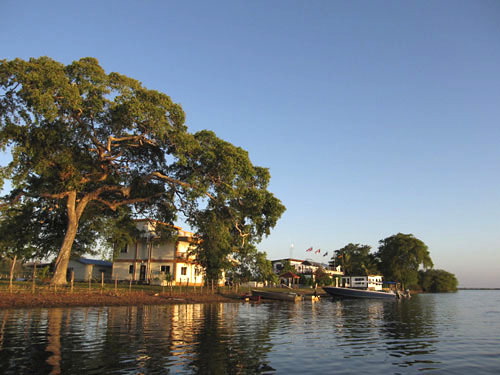
All text, tables, maps, charts & photos © Hilton Pond Center
• PRE-EXPEDITION ACTIVITIES •
(10 March 2012)
Pre-arrival Scouting
Trap Preparation
We departed Hilton Pond on 10 March for a non-stop flight from Charlotte to Belize City, where we were met by Leonard Gillett--a friendly, knowledgeable, helpful, and exceptionally keen-eyed bird guide we had gotten to know well on our two previous trips. Leonard--born in Crooked Tree--is a permanent staff member at Bird's Eye View Lodge (above), where we always stay in Belize.
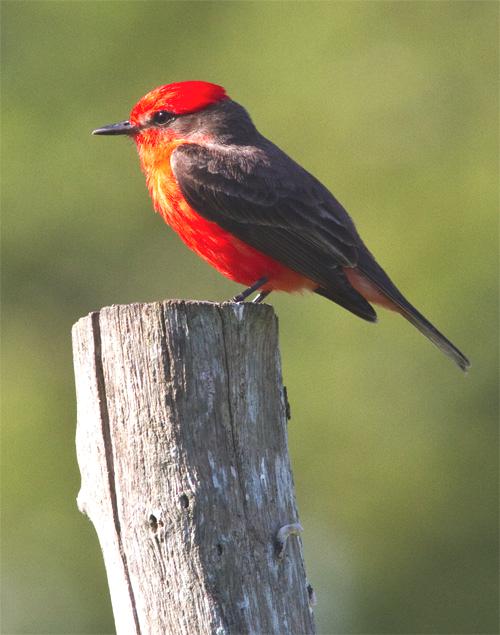
All text, tables, maps, charts & photos © Hilton Pond Center
After a one-hour drive up the "new" Northern Highway we turned onto a gravel road and the causeway that provides the only year-round access to the island village of Crooked Tree. Leonard told us the causeway had been under as much as four inches of water this past winter--a lot, but not quite enough to prohibit passage by motor vehicles. Fortunately, the water had receded, although it was still higher than we'd ever seen it. As we drove onto the island and approached our destination we were met by an aptly named Vermillion Flycatcher male (above)--a familiar and pleasant indicator of the variety of Belizean birds we'd be seeing during the next nine days.

All text, tables, maps, charts & photos © Hilton Pond Center
Sunrise photo courtesy Jared Root
Bird's Eye View Loodge--owned and operated by Norma and Denver Gillett--has comfortable rooms, air conditioning, hot showers, AND the tastiest creole food imaginable; a side porch's east-facing view of the freshwater lagoon (think Great Blue Herons backlit by tropical sunrises, above) is a wonder to behold. Leonard loaded our bags and transported us to the lodge--we arrived a day ahead of the group so we could scout our field sites--along the way bringing us up to speed on Cashew bloom status and the presence of Ruby-throated Hummingbirds. The region had a particularly long rainy season this year so water in the lagoon was indeed deep, but Cashew trees were flowering profusely and there were even a few ruby-throats coming to sugar water feeders at the lodge. With that good news we checked into our room; got reacquainted with old friends Verna, Therese, Evelyn, Stephanie, Michael, and Rudy (among others); hung but did not open four hummingbird traps in the garden beside the lodge; and went off to supper for some typically delicious Creole cooking.
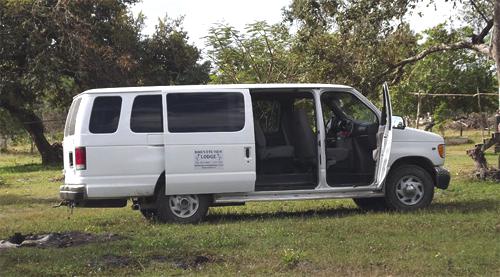
All text, tables, maps, charts & photos © Hilton Pond Center
Van photo courtesy Linda Tucker
• DAY ONE •
(11 March 2012)
Pre-arrival Scouting
Group Fly-in to Belize City
Orientation
We were up bright and early on 11 March to have breakfast and scout the study sites--facilitated by an aging 15-passenger van (above) that lodge owner Denver Gillett is kind enough to lend us each year for transporting gear and participants over dirt roads to various Crooked Tree locations. Not counting the garden and hummingbird feeders at the lodge itself, we have three main study areas--all on private property, and all within a mile or two of the lodge.
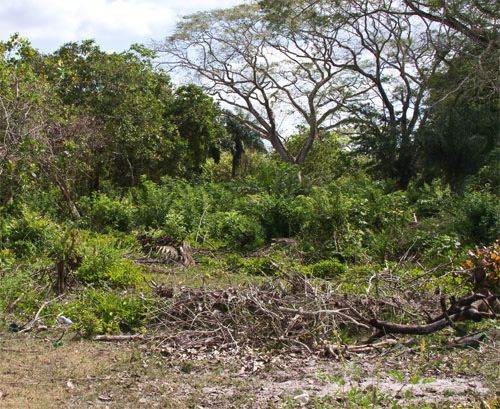
All text, tables, maps, charts & photos © Hilton Pond Center
Our most productive site in Belize during Year One (2010) was a very nice woodlot across from the community hurricane center. Between Years One and Two, however, a squatter came into the "Hurricane Site" (HUR) and cut much of the bird-rich shrub and understory layer (above), completely altering the mix of avifauna and giving us many fewer captures there in 2011. So, last year we moved to a new site (REY) on property belonging to the Reynolds family. That locale was fairly productive, but as luck would have it, this year's scouting trip revealed REY likewise had been defoliated since we worked it last year. Such alteration of study sites is unfortunate but not new to Operation RubyThroat; back at Cañas Dulces in Costa Rica a local businessman even dug up an entire 500-acre nectar-producing Aloe Vera plantation and replaced it with pastureland that supported essentially none of our sought-after Ruby-throated Hummingbirds. We've had similar problems on a lesser scale at our other sites, so the moral of our story--and our strong advice to grad students--is that one should always avoid private property when establishing a place to do long-term field studies.
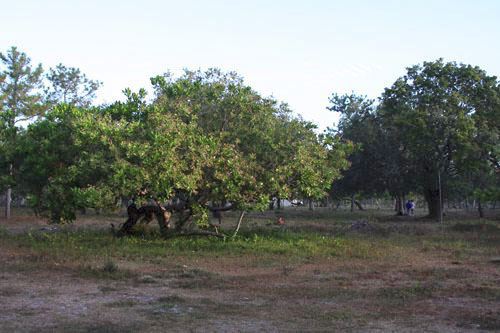
All text, tables, maps, charts & photos © Hilton Pond Center
In any case, we decided for 2012 to work a couple or three days at HUR--which had regenerated somewhat from the 2011 cutting--and then to try REY even though it had been defoliated somewhat since last year. We also kept in mind that our third site--essentially a Cashew savannah (CAS, above) in the backyard of Recia Ward--had produced a few hummers and a bunch of Neotropical songbirds in 2010 and could be used if HUR and/or REY didn't work out. With this plan in mind we were off with Leonard to the Belize City airport to await the arrival of Dr. Skinner and the college kids from Keystone.
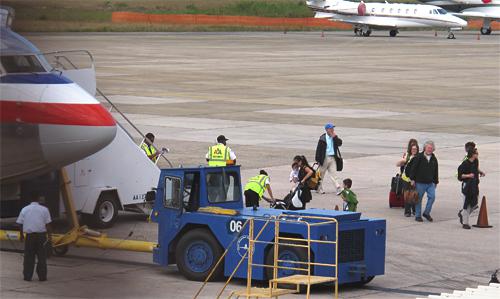
All text, tables, maps, charts & photos © Hilton Pond Center
The Keystone delegation had the unenviable task of making a two-hour drive from the college to get to the Newark NJ airport three hours ahead of their international departure at 7:30 a.m. That meant they left campus at 2 a.m. Some undoubtedly snoozed on the four-hour flight to Dallas/Fort Worth and the second two-hour leg to Belize City, but this was the first international trip for most and adrenaline likely took over. The American Airlines jet arrived a half-hour late, giving us time to go to the airport's "waving deck" from which we could see the group deplaning (above)--with the esteemed Professor Skinner recognizable even at a distance by his gray hair and beard. (No skyways at the Belize City airport--just old-fashioned rolling stairways.)
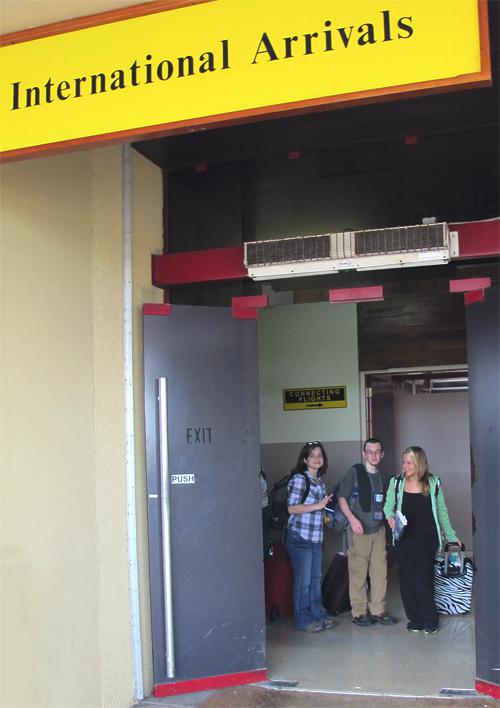
All text, tables, maps, charts & photos © Hilton Pond Center
It took about 45 minutes for everyone to claim baggage and clear customs and for the first students to exit the terminal (above). When the Keystone 12 came through we still had to wait for one more person--that being Juan Diego Vargas, a young Costa Rican nature guide who had worked with us several days on past Operation RubyThroat hummingbird expeditions to his homeland. Juan Diego, a grad student in environmental tourism, was subbing for Ernesto Carman Jr., our long-term tico guide, interpreter, and colleague whose wife Ela was undergoing treatment back home for a massive brain tumor. We knew we'd miss Ernesto, but we looked forward to working with Juan Diego--whom we already knew had the skills, wisdom, temperament, and command of English to be a big help in Belize. JuanD arrived unscathed from his two-leg TACA Airlines trip from San Jose CR to San Salvador to Belize. (Did we mention these were JuanD's first-ever airplane flights?) After introductions all around the Keystone 12 and leaders boarded Leonard's van for the drive back to Bird's Eye View Lodge for check-in, supper, orientation, and--out of deference to the college kids' sleep deprivation--something rare for our Neotropical expeditions: Postponement of the first-night instructional lecture.
• DAY TWO •
(12 March 2012)
First Day of Field Work: Hurricane Center Site (HUR)
Trapping at Lodge
Afternoon Explorations
Our first day in the field started out with first call at 5 a.m., breakfast at 5:30 a.m., and departure for the Hurricane study site (HUR) via van at 6 a.m. sharp. Still running on adrenaline--and in some cases an extra dose of strong Belizean coffee--the team was excited at the prospects, even though a brilliant red sunrise did not bode well weather-wise. We hoped Crooked Tree's unusually lengthy rainy season had already ended but still kept an eye cocked skyward for storm clouds.
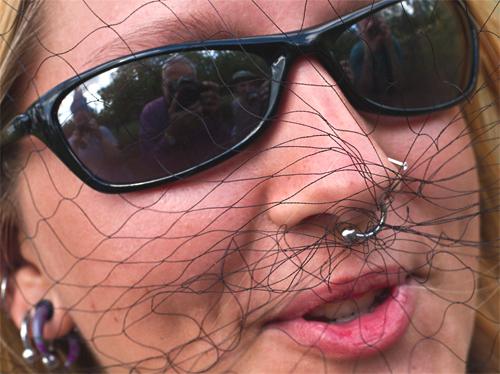
All text, tables, maps, charts & photos © Hilton Pond Center
First task at hand at HUR was to teach our new students how to remove somewhat delicate 42-foot-long mist nets from plastic bags and string them without entanglement on 10-foot tall steel net poles (actually electrical EMT conduit). We cautioned that nets would catch easily on buttons, zippers, dangling earrings, sunglasses, and watches and suggested the students remove or cover up those items while deploying. Everyone took heed--well, almost everyone--and for the first time in three decades of field work one of our helpers got a nose ring caught in the nylon mesh. With considerable patience and extraction skills honed during 30-plus years of bird banding, we finally got the irrepressible Ms. Natalie Bonitz (above) freed from bondage. We had to restrain her peers who wanted to measure and band Natalie right then and there.
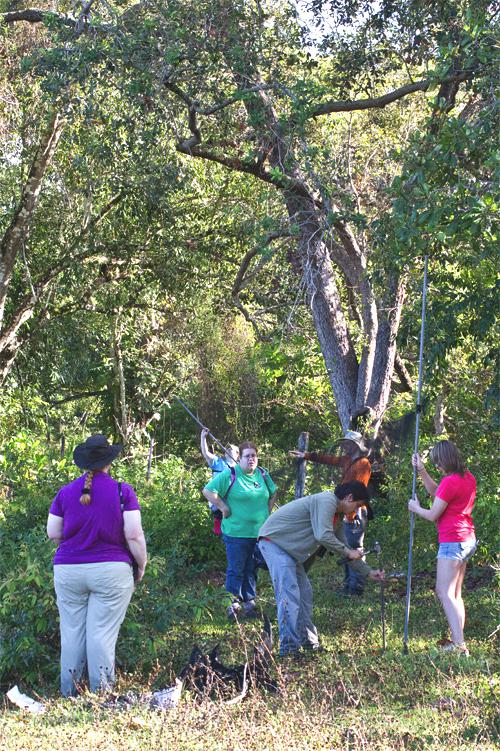
All text, tables, maps, charts & photos © Hilton Pond Center
Other than the nose ring incident, the students were attentive to their duties and got nine nets up by about 8 a.m. in several habitats around the three-acre site (above). We immediately caught a few birds and placed them in lingerie bags for safekeeping prior to examination and banding. Very soon the weather turned ugly and the skies cut loose. Everyone scattered to close the just-opened nets--bird feathers get matted down in wet polyester--and retired to a slightly drier place beneath a big Guanacaste tree at the edge of the site. This was the first time it had rained on any of our 17 Operation RubyThroat expeditions to Central America--not a good way to start the week in Belize.
We didn't expect this mid-March precipitation and had made no provisions for rain gear or a cover over our banding table, so even when the unseasonable downpour slackened a little we had to settle for simply looking at and identifying our recently captured birds rather than banding them and recording data. We re-opened the nets for a while until another cloudburst, at which point we had to call it quits for the day. 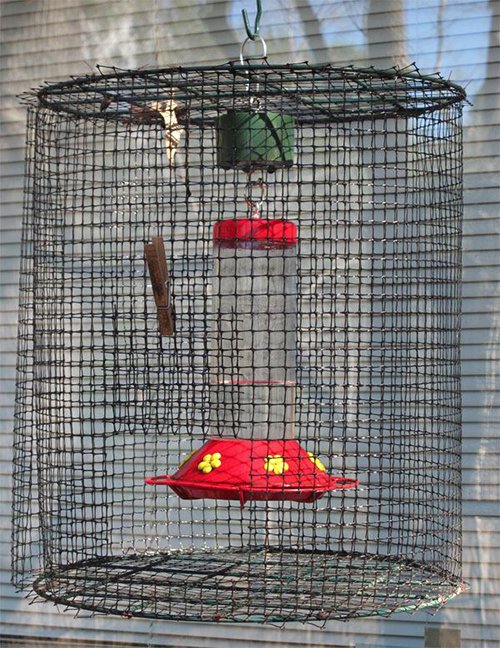 We still managed a lot of bird identification hints that morning but caught no Ruby-throated Hummingbirds, banded nothing, and took no photos in the rain. On the plus side, the students now had net lanes laid out and knew how to deploy mist nets in short order, putting us in good position for a quick start on the next day's field work. We still managed a lot of bird identification hints that morning but caught no Ruby-throated Hummingbirds, banded nothing, and took no photos in the rain. On the plus side, the students now had net lanes laid out and knew how to deploy mist nets in short order, putting us in good position for a quick start on the next day's field work.
That afternoon the group had free time to get better acquainted with trails around Crooked Tree; some even went for a swim in the freshwater lagoon. We also opened four Dawkins traps (right) in the side yard at Bird's Eye View Lodge and immediately began to capture and release the usual expected glut of unbandable Rufous-tailed Hummingbirds. (Sometimes we wish we were studying rufous-tails instead of ruby-throats.) Then, at 1:30 p.m., something remarkable happened: We trapped a female Ruby-throated Hummingbird with a band on her leg. This was a pretty exciting occurrence, for we had yet to band any RTHU in Belize in 2012. That meant the hummer either had been banded elsewhere, by someone else, or by an Operation RubyThroat group in a previous year. We carefully read the band number as L42826 and referred to our banding archives that revealed this bird had been captured in the very same trap at Bird's Eye View Lodge on 4 March 2011--a year and a week previous and making this bird a mighty important one. This was the first time anyone had ever documented later-year site fidelity for Ruby-throated Hummingbirds in Belize--just as we had been the first to show this phenomenon for RTHU on their wintering grounds at three different study locales in Costa Rica. This was an significant discovery for Belize and provides valuable evidence supporting the need to protect Ruby-throated Hummingbird habitat along and on BOTH ends of the species' migratory routes.
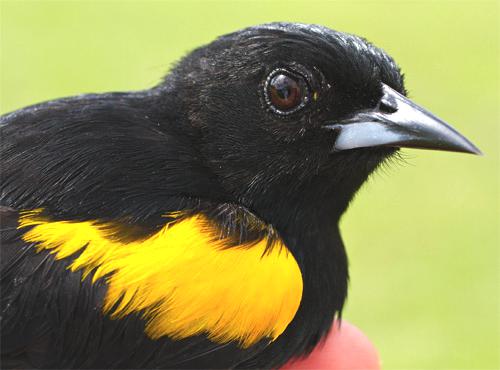
All text, tables, maps, charts & photos © Hilton Pond Center
At 3:15 p.m. at the lodge we also managed to trap one unbanded Ruby-throated Hummingbird--an adult female undergoing wing and tail molt. Traps baited with sugar water also attract other very different kinds of nectar-eating birds, as shown by our capture of a brightly plumaged adult male Black-cowled Oriole (above). We didn't band the oriole because it's a resident species; our Belize and U.S. federal permits allow us to put bands only on Neotropical migrants that might be encountered back north in the U.S. or Canada.
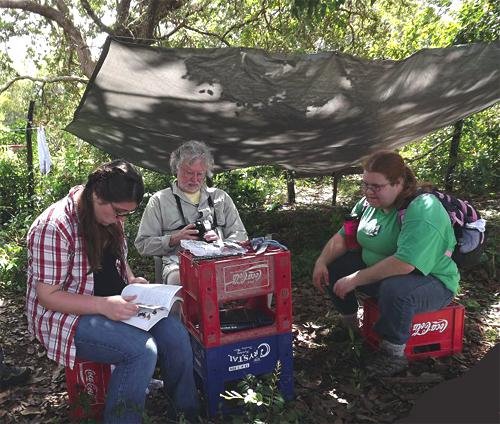
All text, tables, maps, charts & photos © Hilton Pond Center
Tarp photo courtesy Emily Rinaldi
• DAY THREE •
(13 March 2012)
Second Day of Field Work: Hurricane Center Site (HUR)
Afternoon Field Trip to Altun Ha
It was still cloudy early on the morning of 13 March, so first thing the crew did at the Hurricane site was put up a plastic tarp (above) borrowed from the lodge. (Having taken this precaution, of course, it never rained again during our time in Belize.) Things went well in the field, with nets going up quickly and the Keystone 12 stationing themselves to watch for captured birds.
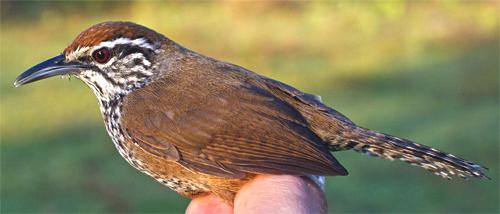
All text, tables, maps, charts & photos © Hilton Pond Center
One of the first species to hit the nets presented the group with an opportunity to learn how to use their field guide to birds of Belize. Because the students had varying levels of expertise, we started with the basics--how the guide is separated into perching and non-perching birds--and went on to what one should look for when identifying birds in the field (or in the hand): Size, shape, and color--plus behavior. The bird above had a typical bird shape, although the wings were a bit short and the bill was slightly decurved. The overall color was brown, with an eye line and dark spots against a white breast and belly. A critical field mark, however, was barring in the tail and wings--typical of the Wren Family (Troglodytidae). Indeed the Keystone 12 had just caught a Spot-breasted Wren, a resident species on Crooked Tree that would not be migrating north.

All text, tables, maps, charts & photos © Hilton Pond Center
Unfortunately we mist netted no ruby-throats that morning, but because Neotrops and non-migrants got caught in nearly all our nets we frequently called the group to the banding table for show-and-tell and exercises in bird identification. One bird we caught (above) defied its classification in the Blackbird Family (Icteridae); it most certainly was not all black. This was an adult Hooded Oriole male even more brilliantly plumaged than its Black-cowled Oriole cousin trapped the day before. Hooded Orioles do occur in California, extreme southwestern U.S., and south Texas and migrate to Mexico, but because there is a resident population in Belize we didn't band this colorful individual.
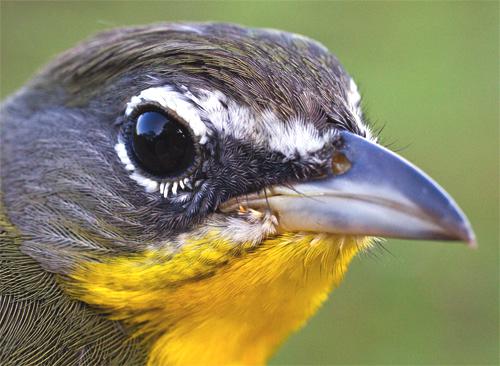
All text, tables, maps, charts & photos © Hilton Pond Center
We did, however, put a band on a big-billed Yellow-breasted Chat (above). Chats are definitely Neotropical migrants that breed throughout North America and into central Mexico, migrating as far south as western Central America in winter. What is unclear about the species is whether a chat is truly a Wood Warbler (Parulidae) as depicted by most field guides. It's a lot bigger than the rest of the warblers and is built a bit differently, so taxonomists are still undecided. Chats actually may be tanagers . . . or blackbirds . . . or cardinals . . . or maybe they're just chats. In any case, this species is in decline across North America--we haven't seen one in years at Hilton Pond Center--mostly due to nationwide loss of habitat and increased nest parisitization by Brown-headed Cowbirds.

All text, tables, maps, charts & photos © Hilton Pond Center
Photo courtesy Linda Tucker
On 13 March we also banded two American Redstarts, three Common Yellowthroats, one Magnolia Warbler, two White-eyed Vireos, two Yellow Warblers, one Ovenbird, two Summer Tanagers, and one Yellow-breasted Chat--a busy day in the field. This gave our student group plenty of time to practice identification skills, hold birds, and take photographs (Nick McDonald, above).
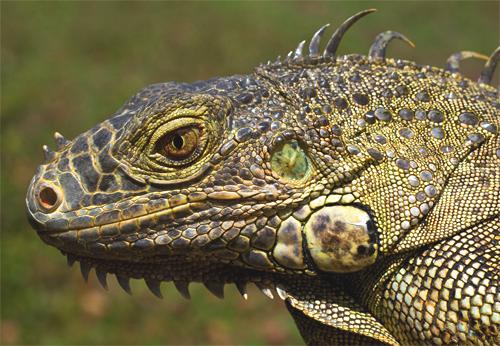
All text, tables, maps, charts & photos © Hilton Pond Center
As we were running mist nets at the Hurricane site a trio of local men wandered through while carrying a three-foot-long lizard. They asked if we'd be interested in buying; if not they would be having it for supper. Turns out the lizard was a male Green Iguana, Iguana iguana, that Belizeans refer to appreciatively as "bamboo chicken." We declined the option to purchase but did take photos of this primeval-looking reptile that--we found out later--did indeed end up in a stew pot.
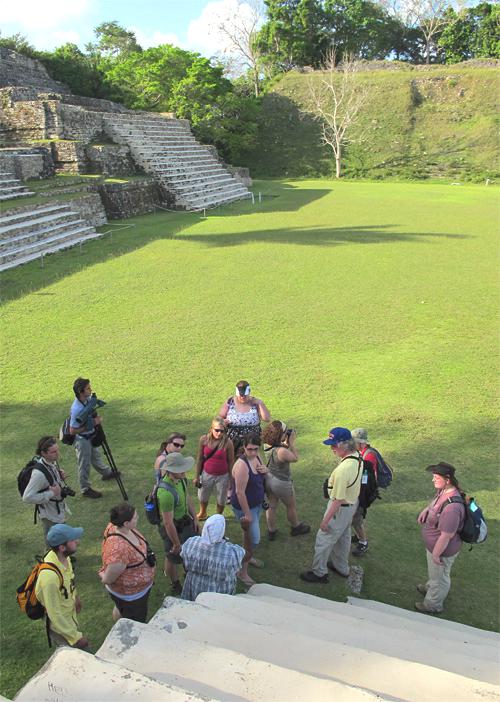
All text, tables, maps, charts & photos © Hilton Pond Center
We caught no Ruby-throated Hummingbirds at the Hurricane site that morning. We also didn't run traps at the lodge that afternoon because the group headed back toward the northeast for a field trip to Altun Ha, a partly restored Mayan settlement. There we met up with old friend Ann-Marie Avona, a jovial and entertaining Creole guide who always delights us with her tales of ancient Mayan lifestyle. This extensive settlement covers nearly five square miles and was first inhabited about 200 BC. The central city includes perhaps 500 structures, the largest of which are temple/tomb pyramids (above) built in traditional Mayan stair-step style.

All text, tables, maps, charts & photos © Hilton Pond Center
The Keystone 12 charged enthusiastically up the "tourist steps" on one of the pyramids to view the entire site. Somehow they seemed far more hesitant (above) on the way back down.
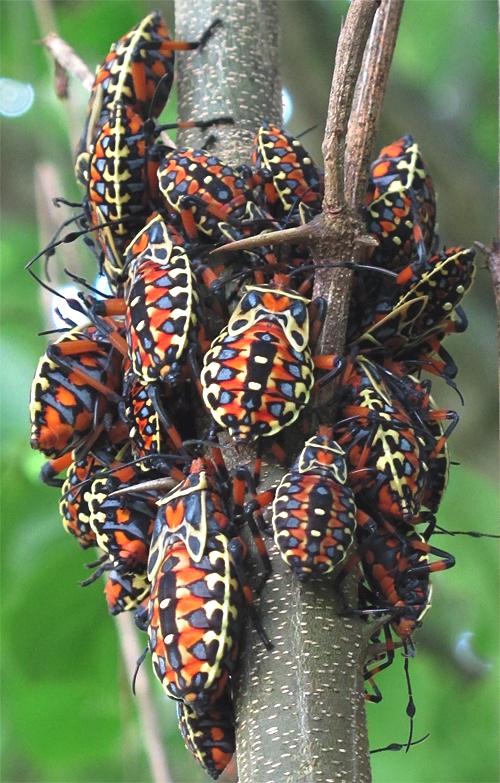
All text, tables, maps, charts & photos © Hilton Pond Center
Other than the brightly painted souvenirs at Ann-Marie's shop, perhaps the most colorful thing we saw at Altun Ha was the cluster of nymphs (above) of a true bug (Hemiptera). We're not sure of the identification, but we suspect some species of Harlequin Bug.
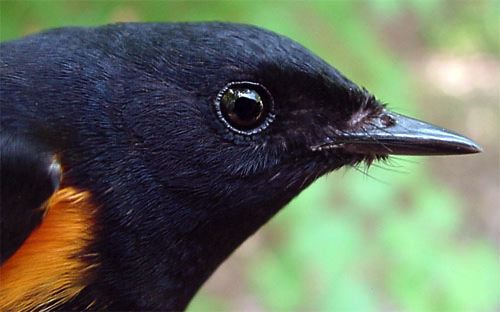
All text, tables, maps, charts & photos © Hilton Pond Center
• DAY FOUR •
(14 March 2012)
Third Day of Field Work: Reynolds Property Site (REY)
Afternoon Field Trip to Belize Zoo
Despite success banding Neotropical migrants during our second day of mist netting at the Hurricane site, we decided for Day Three (14 March) to shift further afield to the Reynolds property--the site we had used in 2011 and that had been partially defoliated sometime shortly thereafter. This turned out to be a good move. The group scouted the five-acre plot for appropriate net lanes and in several cases chose precisely the same locations we had used last year. It wasn't long before the first call of "Bird!" sent Juan Diego to extract a male American Redstart in adult plumage (above). New captures on 14 March included two American Redstarts, two White-eyed Vireos, three Black-and-white Warblers, one Magnolia Warbler, one Ovenbird, one Yellow-breasted Chat, and two Summer Tanagers.
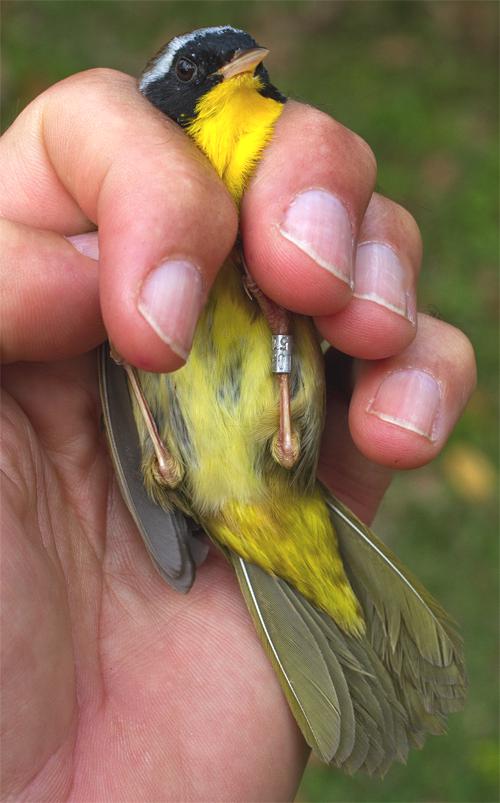
All text, tables, maps, charts & photos © Hilton Pond Center
At 8:35 a.m. JuanD also extracted a male Common Yellowthroat that had a band on its leg. We already had handled three yellowthroats in 2012 over at the Hurricane site, but this bird's band was dull and old--not shiny and new. A quick look at our archival records indicated this individual had been banded on 5 March 2011 here at the Reynolds site--our first-ever return of a songbird that wintered in Belize and flew back north to breed before coming back again in a subsequent year. Amazingly, a few hours later we caught a second Common Yellowthroat--this one banded last year on 4 March.

All text, tables, maps, charts & photos © Hilton Pond Center
As if two Common Yellowthroats weren't enough, at 10:55 a.m. the crew mist netted a female Magnolia warbler (above) that also carried an old band. A check of our records indicated she, too, had been banded on 5 March 2011 at the Reynolds locale. Three returns in one morning was pretty phenomenal and showed very precise winter site fidelity by these Wood Warblers. It looked like the BeLevens--those citizen scientists that helped us in Belize last year--had done a pretty good job of mist netting birds that, in turn, were to be recaptured a year later by the Keystone 12.
Also of significance on 14 March was the Reynolds site capture of three new Ruby-throated Hummingbirds--two second-year males with incomplete gorgets and an after-hatch-year female whose exact age could not be determined. We banded these and pleaded with them to move northward for possible recapture on a distant breeding territory in the U.S. or Canada. Our RTHU total now stood at four. Things were rolling along pretty well for the Keystone 12, but we had to shut down operations at noon for lunch and an afternoon field trip to the Belize Zoo.
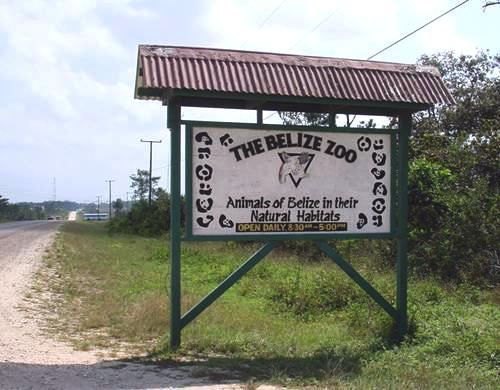
All text, tables, maps, charts & photos © Hilton Pond Center
About 90 minutes from Crooked Tree on the Western Highway, the Belize Zoo near Ladyville was established in 1993 as a "last ditch effort to provide a home for a collection of wild animals which had been used in making documentary films about tropical forests." These days the zoo is home to more than 150 animals representing 45 species--all native to Belize. The facility lays claim to being "the best little zoo in the world" and really is quite nice and worth a visit.

All text, tables, maps, charts & photos © Hilton Pond Center
A favorite of zoo visitors--including the Keystone 12--are exhibits that contain big cats in natural habitats. Almost everyone is drawn to the fully grown Jaguar (above) that calls the zoo home. This animal was rescued as a kitten and hand-reared at the zoo and, in our judgment, is a real ham.
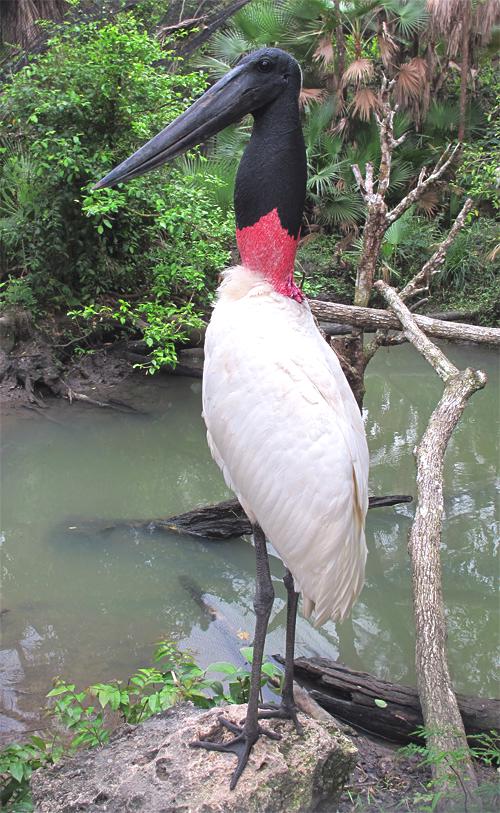
All text, tables, maps, charts & photos © Hilton Pond Center
Big felines are indeed impressive, but our favorite creature at the Belize Zoo is the Jabiru stork (above)--a pretty big animal in its own right. At five feet this is the tallest flying bird in the Western Hemisphere, while its wing span of nine feet is second only to the Andean Condor. Even the slightly recurved 14" bill--used to deftly catch eels, fish, amphibians, and just about anything else small enough to swallow--is massive.

All text, tables, maps, charts & photos © Hilton Pond Center
A mock-up of a Jabiru with spread wings gives an idea of just how big this bird really is--especially when compared to the five-foot arm span of Keystone College student Emily Rinaldi (above). Emily is petite, but even so the Jabiru is huge. We're glad our group got to see these giant storks at the zoo because high water at the Crooked Tree lagoon meant they weren't foraging as usual around the lodge. (In 2010 we saw more than 50 Jabiru at one time wading and feeding in the lagoon--well over half the rare species' entire Belizean population.)
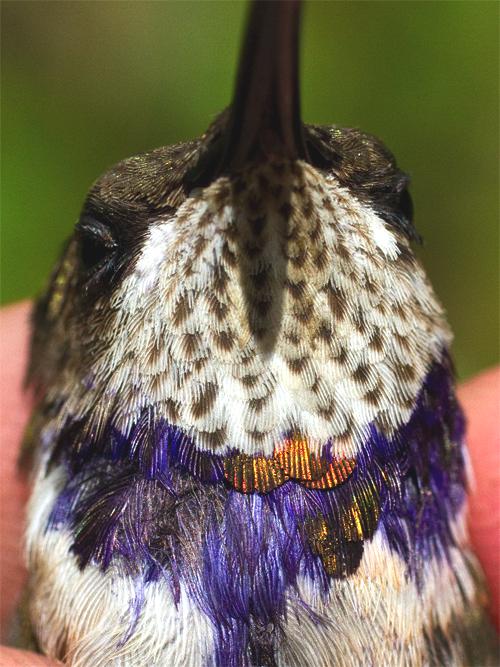
All text, tables, maps, charts & photos © Hilton Pond Center
• DAY FIVE •
(15 March 2012)
Fourth Day of Field Work: Reynolds Property Site (REY)
Trapping at Lodge
Afternoon Lagoon Boat Ride
On 15 March the group returned to the Reynolds property and got nets deployed quickly--as indicated by the capture of one second-year male Ruby-throated Hummingbird (above) at 7:10 a.m. He had a throat heavily streaked with greenish-brown and was just bringing in some iridescent red feathers on his otherwise immature gorget. As shown in the photo, all ruby-throats in Belize are anointed with non-toxic temporary dye that allows us to observe them with binoculars after banding and release. Even though the dye wears off in about a month, folks back in the U.S. should keep an eye out for color-marked RTHU (purple from Belize, turquoise from Costa Rica, and green from Hilton Pond Center).
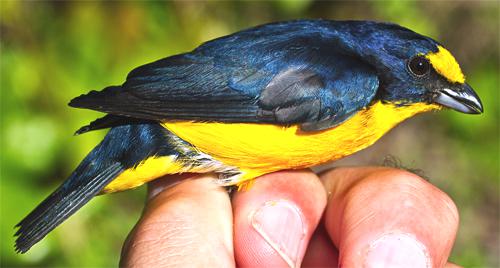
All text, tables, maps, charts & photos © Hilton Pond Center
Shortly after we banded the young male hummer we caught an eye-popping blue-and-lemon-colored bird with a stout black bill (above). There was no question in our group's collective mind that this was a breeding male Yellow-throated Euphonia, a member of the diverse Tanager Family (Thraupidae). A non-migrant, the euphonia was not bandable, but we did put bands on the other migratory species we caught that morning, including one American Redstart, two Magnolia Warblers, one Hooded Warbler, and one Orchard Oriole--the latter being the first of its species we'd handled in Belize. Of greater significance was a bird with an old band captured at 9:15 a.m.--our second returning female Magnolia Warbler. This one had been banded on 6 March 2011 and showed up again this year. That made it FIVE returns to date for the Keystone 12: Two Magnolia Warblers and two Common Yellowthroats on the Reynolds tract--plus the retrap of the "old"
Ruby-throated Hummingbird at Bird's Eye View.
With another successful morning in the field completed, the group rode back to our home base for lunch. During a couple of hours of free time we opened the traps at the garden and caught one new female ruby-throat, bringing the 2012 total for our target species to six. We also spent a LOT of time clearing the traps of those pesky, unbandable Rufous-tailed Hummingbirds--at least two dozen of which entered the traps.
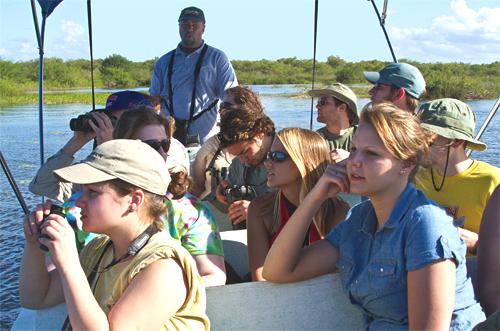
All text, tables, maps, charts & photos © Hilton Pond Center
At mid-afternoon the group boarded a 15-person runabout piloted by Cap'n Leonard and headed out for an afternoon boat tour of the lagoon and its backwaters. This is a great way to view birds and other aquatic wildlife because watercraft can get quite close before spooking such quarry. Binoculars and cameras at the ready, the Keystone 12 was treated to views of numerous bird species they might never see from a land-based observation point.
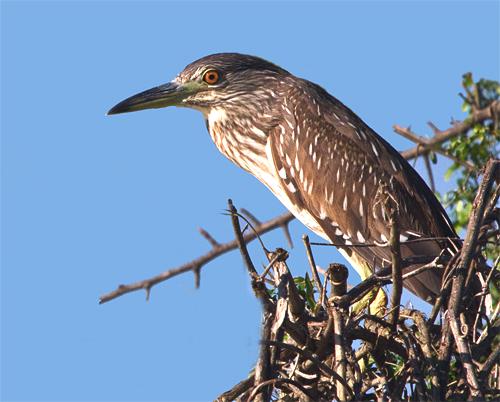
All text, tables, maps, charts & photos © Hilton Pond Center
Leonard went slow or fast, sometimes shutting off the engine completely so we could drift close to birds such as the immature Black-crowned Night Heron above. This was one of the more common waders at the lagoon but--as the name suggests--it was seldom seen in daylight. Some of our best looks of night herons actually came via carefully aimed spotlight after dark.
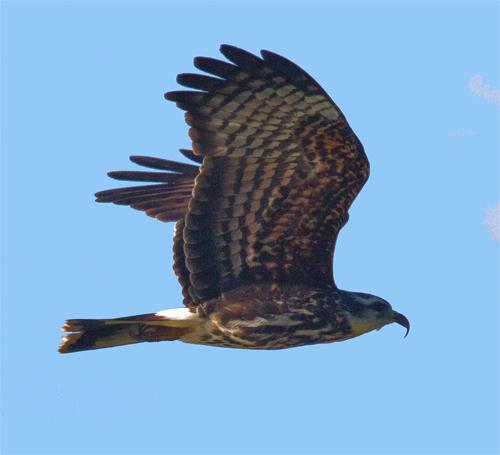
All text, tables, maps, charts & photos © Hilton Pond Center
As we drifted southward on the lagoon we saw several birds of prey associated with freshwater habitats. One was a Snail Kite (above) whose name and thin, heavily decurved bill indicate a specialized diet of univalves. This was an immature in brown and white plumage; adult Snail Kites have slate-gray bodies and heads. The species is considered endangered in southern Florida but is quite common in Central America.
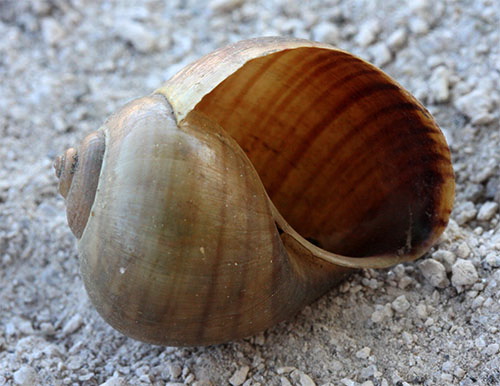
All text, tables, maps, charts & photos © Hilton Pond Center
Snail Kites specialize in eating Apple Snails (above), their decurved bills adapted for prying the snail's body from the helical shell in one piece. Empty shells like the one above indicate the snail has fallen victim to a kite; by comparison, a shell with a hole likely has been damaged by hammering from the heavy straight bill of a Limpkin--a rail-like wading bird in its own family (Aramidae).
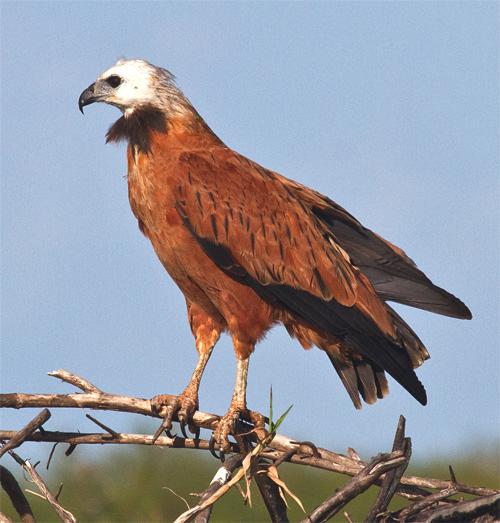
All text, tables, maps, charts & photos © Hilton Pond Center
We also got exceptionally good looks at second bird of prey, an adult Black-collared Hawk (above), whose decurved bill wasn't as sharp as that of the kite. This raptor usually nests near water where it uses its rough talon-armed feet to capture fish. It occasionally eats Apple Snails and may also dine on lizards and rodents along the water's edge.
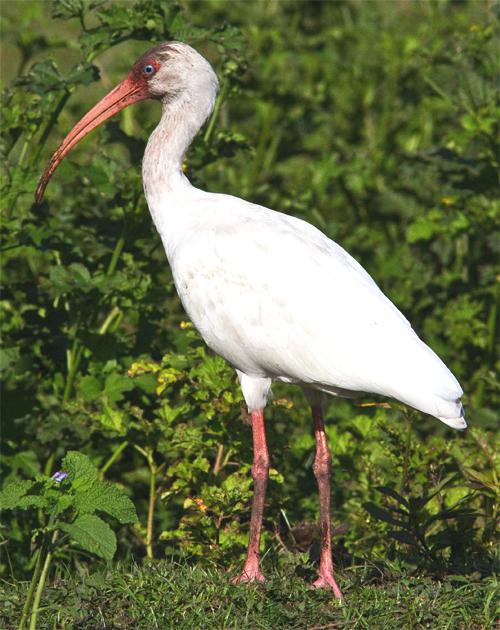
All text, tables, maps, charts & photos © Hilton Pond Center
All sorts of riparian birds were visible during the lagoon boat ride, including herons, egrets, kingfishers, cormorants, ducks, and Jaçanas. Among our favorites, however, were adult White Ibises (above) whose bright plumage and gracefully decurved bills were most pleasing to the eye. One White Ibis is great to look at, but most idyllic were long V's of these birds skimming across the surface of the water each evening when they went to roost.
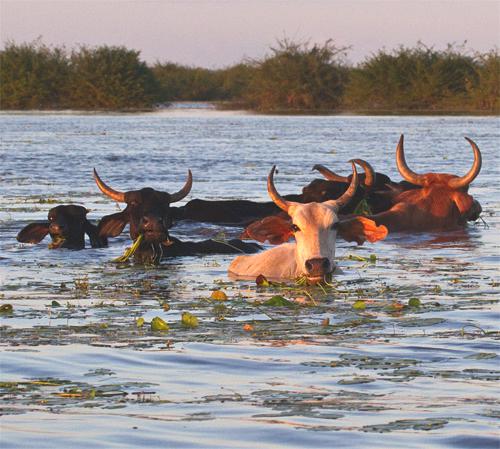
All text, tables, maps, charts & photos © Hilton Pond Center
As the lagoon tour neared its end, the passengers noticed some large animals in the water ahead of the boat. Leonard steered us toward the horned beasts and explained they were Brahma cattle wading or treading water while they chowed down on succulent water lily leaves. These hefty cows--raised for meat throughout Belize--seemed content so we slowly motored away and left them in peace as the sun set in the west.
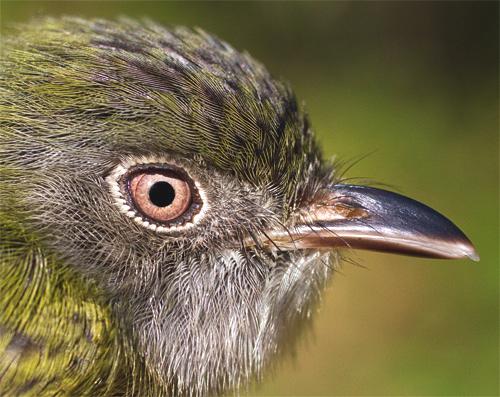
All text, tables, maps, charts & photos © Hilton Pond Center
• DAY SIX •
(16 March 2012)
Final Scheduled Day of Field Work: Reynolds Property Site (REY)
Bird Club Visit
Shopping Trip to Belize City
The Keystone 12's fifth and final day in the field came on 16 March as the group boarded the van with mixed feelings--eager to catch more birds but sad their Neotropical expedition was drawing to a close. We elected to go back to the Reynolds site one more time and started the morning with capture of a tiny bird scarcely 3.5 inches long (above). Its pale iris reminded us of a White-eyed Vireo but the upper mandible was distinctive, telling us this was a Northern Bentbill--one of many non-migratory flycatchers in the Neotropics.

All text, tables, maps, charts & photos © Hilton Pond Center
We also caught and banded numerous migrant parulids, including two American Redstarts, one Tennessee Warbler, one Yellow Warbler, one Black-and-white warbler, and three Ovenbirds--plus a female Painted Bunting and an Orchard Oriole. An especially welcome capture was a second-year male Black-throated Green Warbler (above)--the first of its species we had banded in three years of work in Belize. We also netted one second-year male Ruby-throated Hummingbird, bringing the 2012 total to seven.
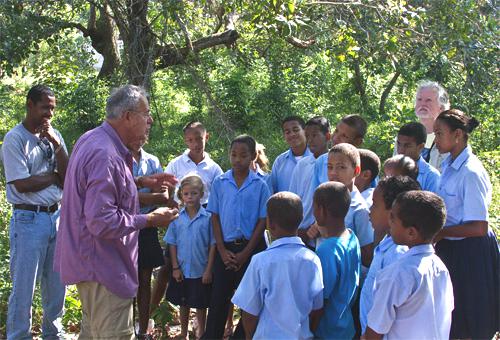
All text, tables, maps, charts & photos © Hilton Pond Center
Photo courtesy Juan Diego Vargas
We were happy at mid-morning to host the Crooked Tree student bird club, a group organized and instructed by Derrick Hendy (above left)--a ranger with Belize Audubon Society. These eager kids walked and rode bicycles from a nearby school to learn more about our on-going hummingbird research in and around their village.
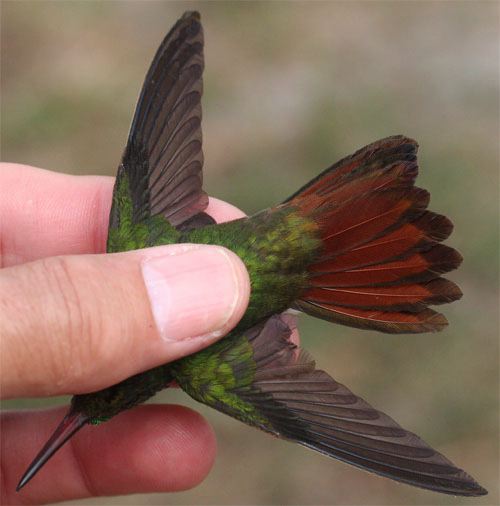
All text, tables, maps, charts & photos © Hilton Pond Center
Inquisitive, attentive, and well-behaved, the students were fascinated as we showed them how we capture, handle, band, measure, and release Ruby-throated Hummingbirds, warblers, and other Neotropical migrants. A few were even more ecstatic when they got to handle and release birds we had been holding for their examination. Most impressive were several students who did not hesitate in identifying the bird just above as a Rufous-tailed Hummingbird. Ranger Derrick has many goals for these young people, one of which is to encourage them to develop birding skills so they can become a new generation of nature guides at Crooked Tree. 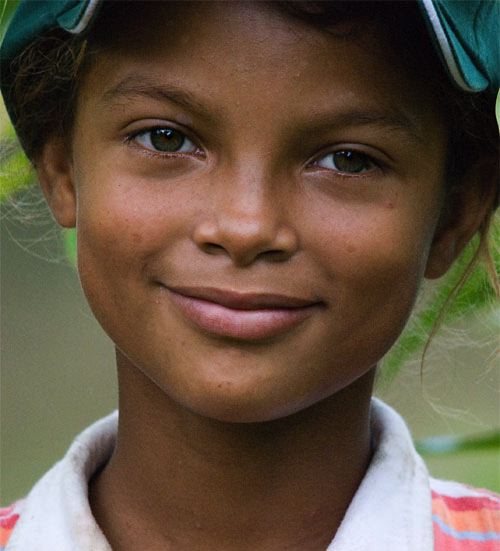 Our own goal was to make club members more appreciative of the many feathered creatures that belong not to Belize or to North America but to everyone who lives or works or plays where these birds occur. Our own goal was to make club members more appreciative of the many feathered creatures that belong not to Belize or to North America but to everyone who lives or works or plays where these birds occur.
The young people were delightful and we were especially glad to see Khadija (left)--our little friend whose curiosity brought her to Operation RubyThroat study sites in past years--had joined the bird club. We wished we'd had longer to spend with the kids from Crooked Tree, but teachers back at school were prepping them for standardized testing and were jealous of the time. Thus, the Keystone 12 group bid farewell to their younger Crooked Tree counterparts and went back to the business of tending mist nets until noon when we took them down for what we thought would be the last time in 2012. After lunch we finally relented to the college group's relentless requests for a souvenir fix and drove off with them to Belize City for an afternoon of shopping and other touristy things.
• DAY SEVEN •
(17 March 2012)
Optional Day of Field Work: Recia Ward's Cashew Farm (CAS)
Trapping at Lodge
Keystone 12 Fly-out
Omega Group Afternoon Field Work (CAS)
On the evening of 16 March we gathered the Keystone 12 for a meeting in which we looked at results of our five days in the field. As we projected banding totals on the wall we had a brainstorm: Since the group's flight wasn't departing from Belize City airport until 3 p.m., might anyone be interested in an optional half-morning of mist netting the next day? Prof. Jerry Skinner and five of 11 students jumped at the chance, especially when we mentioned we'd be going to Recia Ward's Cashew savannah (CAS) where we had run nets in 2010 but not last year. With this special volunteer crew lined up, Juan Diego knocked on selected doors on the morning of St. Patrick's Day and we were off and running as the sun peeked over the horizon beyond Crooked Tree Lagoon. The crew ended up working for just three hours at CAS, but when we returned to Bird's Eye View Lodge to announce our results the rest of the students collectively kicked themselves for not getting up with those stalwart volunteers. Our glowing report for CAS was as follows.
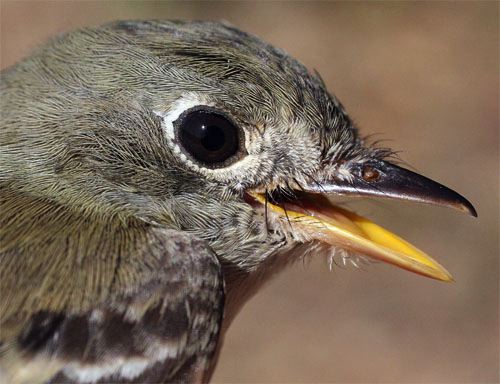
All text, tables, maps, charts & photos © Hilton Pond Center
At 7 a.m. we netted a female Ruby-throated Hummingbird at CAS, followed by another at 8:05 a.m. (These two gave us nine for the year.) At 8:05 a.m. in different nets we also caught two OTHER Neotropical migrants of special interest. The first was a Least Flycatcher (above) that had an old band on its leg. We checked our records to find that #2610-53113 had been captured at CAS on 8 March 2010--TWO years previous.
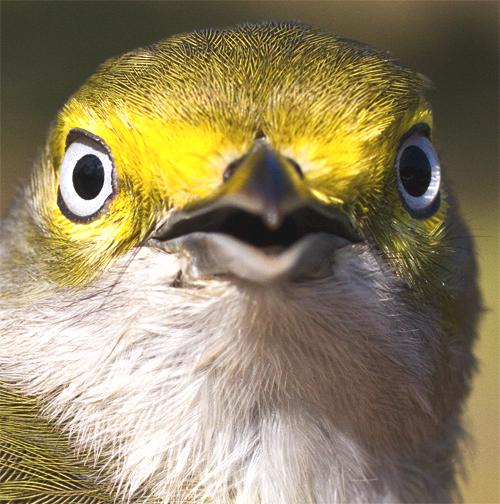
All text, tables, maps, charts & photos © Hilton Pond Center
The second bird in question was a White-eyed Vireo (above) that ALSO wore a dingy old band on its leg. This bird was #2610-53117, captured at CAS on 9 March 2010. We found it remarkable that two Neotropical migrants banded a day apart two years previous were in adjoining nets during the same net check in 2012. Odds are those two birds were also present at CAS last year when we didn't work the site.
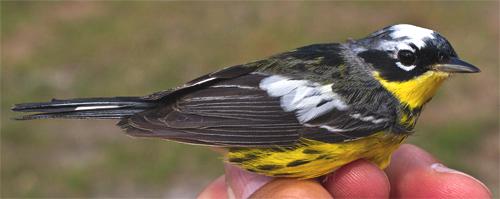
All text, tables, maps, charts & photos © Hilton Pond Center
In just three hours the last-morning volunteers got so see some other interesting birds, just one of which was bandable. That happened to be a male Magnolia Warbler in aberrant breeding plumage (above). Although the species typically has a prominent white wing patch and big white tail spots, this particular bird wore a white crown that should have been dark gray--an example of leucism (partial albinism).
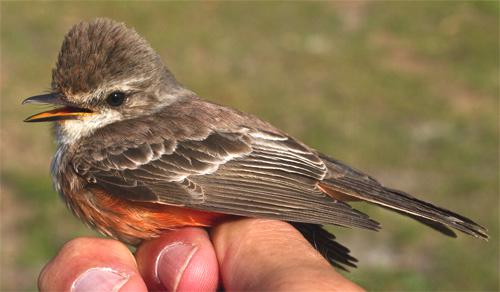
All text, tables, maps, charts & photos © Hilton Pond Center
A little later we caught a bird with what appeared to be a really big head (above), but in reality it was a female Vermillion Flycatcher her tall crest erected. This individual had a partially developed brood patch--a good sign she was about to start incubating--so we took just a few photos and released her quickly.
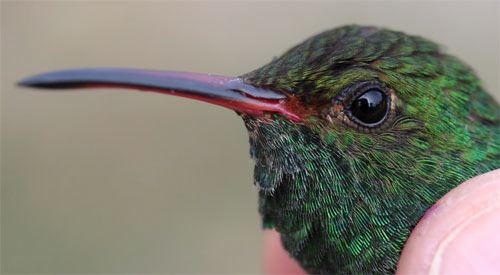
All text, tables, maps, charts & photos © Hilton Pond Center
We also netted the usual complement of Rufous-tailed Hummingbirds (above), a species so prevalent on our study sites in Belize and Costa Rica we've decided it must be the second-most-common hummer in the world--right after ruby-throats.
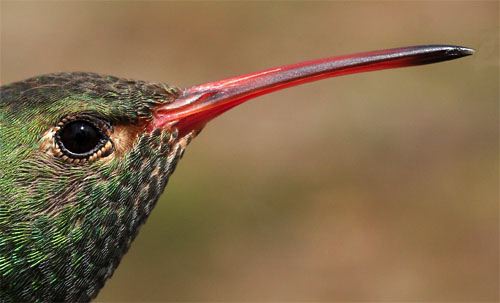
All text, tables, maps, charts & photos © Hilton Pond Center
It turned out, however, that one hummingbird (above) that appeared to be a rufous-tailed wasn't. Thanks to great diligence by Juan Diego--who looked carefully at every hummer we captured--we saw that one rufous-tailed look-alike was actually an immature Buff-bellied Hummingbird distinguishable by faint buffiness on its underside where a rufous-tailed would be pure white. As the two photos above indicate, the two species look remarkably similar in head view, especially since both have rusty tails to boot.
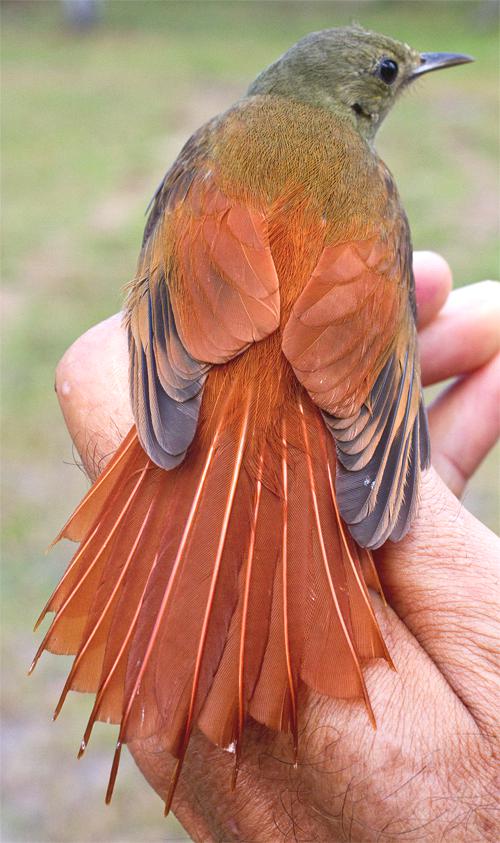
All text, tables, maps, charts & photos © Hilton Pond Center
And speaking of rusty tails, we spent a little time studying one of our other captures at CAS--an Olivaceous Woodcreeper (above). Members of this subfamily (Dendrocolaptinae) of the Ovenbird Family (Furnariidae) resemble Old World Treecreepers (Certhiidae) and behave somewhat like woodpeckers (Picidae) but are related to neither. One characteristic woodcreepers share with woodpeckers, however, is very stiff tail feathers that in most woodcreepers even lack a vane near the feather tips. Such stiff rectrices serve as the third leg of a tripod--the bird's legs are the other two--and helps a woodcreeper (or woodpecker) move up a tree trunk while foraging for insects in the bark. What an interesting bird to end the morning for the small cadre of Keystone 12's who wanted to get up early for one more day of bird banding! With the woodcreeper photographed and released, we closed the mist nets at CAS but saved time by leaving them in place under the watchful eye of Recia Ward.
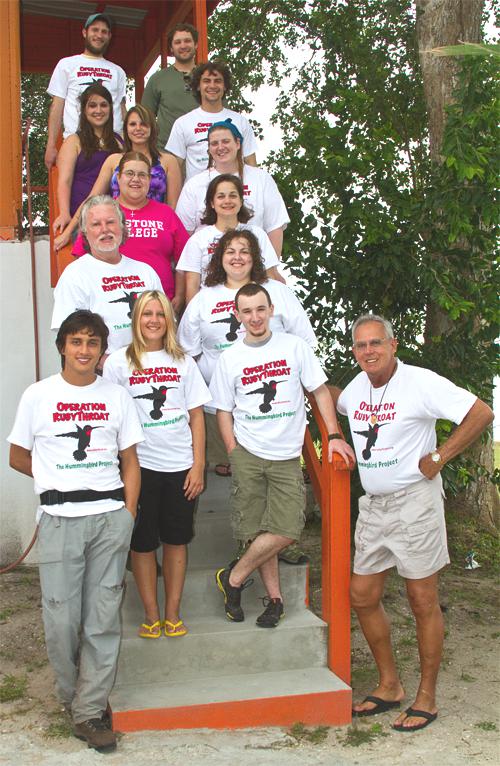
All text, tables, maps, charts & photos © Hilton Pond Center
Meanwhile, back at the lodge members of the Keystone 12 gathered one last time to pose--many decked out in exquisite Operation RubyThroat T-shirts--for the traditional group picture (above). Top to bottom and left to right are: Dan Owens, Nick McDonald, Cassie Fogle, Jared Root, Cassie Bostjancic, Linda Tucker, Amanda Rosenberger, Emily Rinaldi, Dr. Jerry Skinner, Chrissy Parise, Natalie Bonitz, Justin Clarke, chief assistant Juan Diego Vargas, and trip leader Bill Hilton Jr. We thanked each and every member of the group for helping underwrite this year's expedition to Crooked Tree in Belize and for being such avid learners and participants in the field.
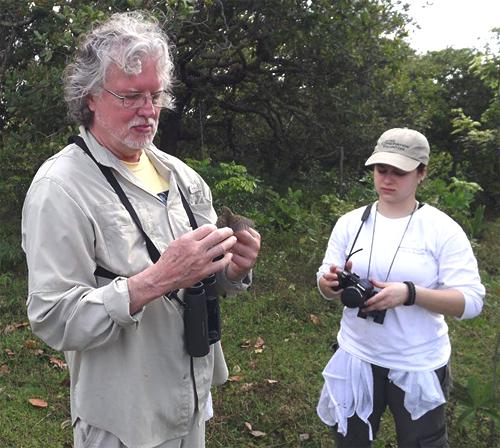
All text, tables, maps, charts & photos © Hilton Pond Center
Photo courtesy Linda Tucker
We especially acknowledged Dr. Jerry Skinner (above left, with Emily Rinaldi) of Keystone College's biology department for recruiting from among his study body a fine group of citizen scientists (and, in many cases, soon-to-be science professionals). Without his preliminary help up in Pennsylvania our Belize expedition would not have occurred in 2012. His enthusiasm equaled ours and that of his students and his assistance and input made for a truly memorable week in the Neotropics at our "hummingbird college."
Finally, it was time to depart Crooked Tree, with hugs all around and even a few tears as we handed out a special talisman for each participant: A "magic" Atomic Fireball candy to suck on during the return flight. We also charged each Keystone student with the responsibility of now being a teacher who would tell anyone who would listen all they learned at Crooked Tree, and we wished them well as they continued their careers. Then, to make wise use of the next 24 hours, we transferred care of the Keystone 12 to Leonard, who drove them to the airport while the Omega Team (Juan Diego and Bill)--not due to depart until the next day--ran traps at the lodge until mid-afternoon.
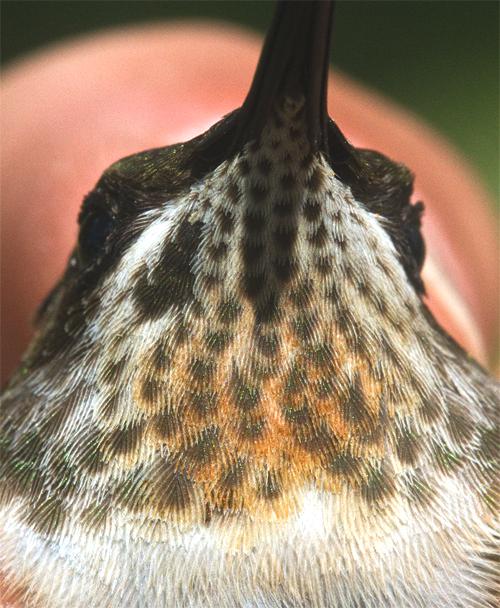
All text, tables, maps, charts & photos © Hilton Pond Center
This stay-behind strategy worked out well and yielded one more second-year male Ruby-throated Hummingbird (above). This bird looked a little odd in-hand because its immature white throat was tinged with cinnamon color. At first we thought this was pollen, but a close look with a 10X hand lens revealed the feathers were stained. We finally put two and two together when we realized lodge owner Denver Gillett sometimes uses brown sugar in the feeders he maintains throughout the year.
At 3 p.m. the Omega Team closed the traps and made one final trip out to the CAS study site. There we re-opened the nets left in place that morning and were more than a little pleased at 5 p.m. to capture one more female Ruby-throated Hummingbird. This was the third RTHU at CAS that day and brought the new total to 11.

All text, tables, maps, charts & photos © Hilton Pond Center
Then, as the shadows grew long and we began taking down the nets, we caught one additional bird of significance: A Northern Waterthrush with--you guessed it--an old band on its leg. In the waning light we checked our records to find this bird (#2421-16320) had been banded at CAS on 7 March 2010, making it the third "old" bird recaptured this day (17 March 2012) after being banded two years earlier. Considering that we banded only 26 Neotropical migrant songbirds at CAS during three field days in 2010, having three of them return on the same day this year defies all odds. We're guessing that means our first group of citizen scientists at Crooked Tree--the Belize-Oneers--must have done a pretty good job sampling the CAS site when they were there in March 2010.
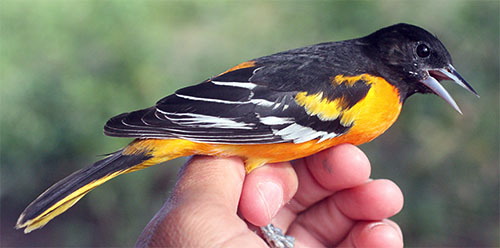
All text, tables, maps, charts & photos © Hilton Pond Center
• FOLLOW-UP ACTIVITIES •
(18 March 2012)
Trapping at Lodge
Omega Group Fly-out
The Omega Group was up before dawn on 18 March, setting the Dawkins traps at the lodge for a few hours before the final airport run. As usual we caught more Rufous-tailed Hummingbirds than we could count, but there was also a much larger bird after the artificial nectar: A brightly plumaged adult male Baltimore Oriole. The oriole eventually made his way into the trap and we quickly had him in hand, where we noticed he carried a band inscribed #2421-16320. Our records showed this patron of sugar water was trapped at the lodge on 4 March 2011. As such, he was an after-third-year bird that served as yet another example of winter site fidelity in a species that breeds back in North America.
The clock was ticking on our departure for the Belize Airport, but as we were taking down the traps we caught one more Baltimore Oriole, this time a second-year female. We banded her in short order, collapsed the Dawkins traps and shut all our suitcases, and met Leonard at the van for our post-expedition trip down the Northern Highway. At the airport the Omega Crew profusely thanked ever-helpful Leonard--he had been driver and local guide on all our area field trips, including the lagoon boat ride--and we started through the check-in process at the airport.
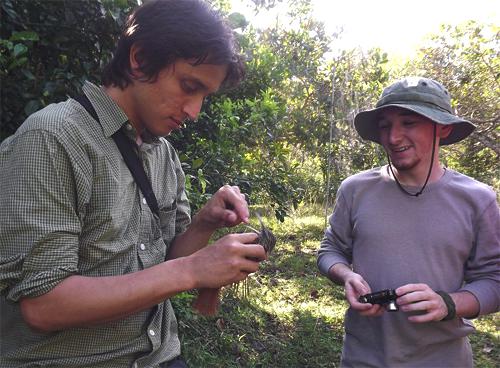
All text, tables, maps, charts & photos © Hilton Pond Center
Photo courtesy Emily Rinaldi
Ticket in hand, trip leader Bill Hilton Jr. departed via USAirways as chief assistant Juan Diego Vargas waited awhile for his TACA flights, first to San Salvador and then home to San Jose, Costa Rica. Before departure, Juan Diego Vargas thanked us several times for "allowing" him to participate in the trip, but the real thanks were due him for stepping in on short notice to replace Ernesto Carman Jr. as our colleague in Belize. JuanD (above left, with Ivory-billed Woodcreeper and Keystoner Justin Clarke) rose to the challenge and served the group well as a bird guide, net tender, bird extractor, teacher, and dependable companion in the field. We look forward to working with him again on future Operation RubyThroat endeavors and to sharing more Belizean sunsets with him (below).
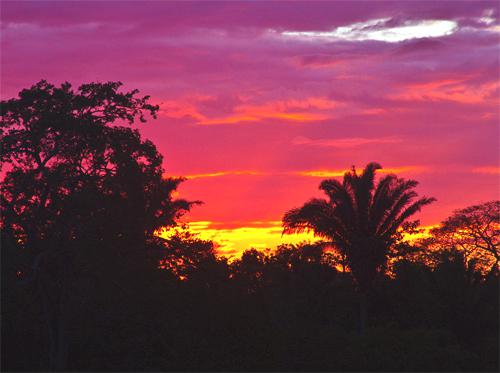
All text, tables, maps, charts & photos © Hilton Pond Center

All contributions are tax-deductible
BELIZE BANDING RESULTS,
2012 & CUMULATIVE
Our 2012 expedition to Belize was productive, even though we ended up banding only 11 of our target species, the Ruby-throated Hummingbird (RTHU), Archilochus colubris. During our Operation RubyThroat 2010 field season at Crooked Tree we netted or trapped 54 RTHU, and last year banded 18. This year's trip was a full week later than the first two, so we suspect low numbers might be the result of hummers already moving north in migration. Adult males--which arrive first on breeding grounds in North America--were essentially absent this year; none were trapped and we observed only one during the entire week. We now have banded 83 ruby-throats among the Cashews at Crooked Tree; prior to our work just two RTHU had been banded in the entire country of Belize.
Our most significant encounter of 2012 was the re-trapping at Bird's Eye View Lodge of a female Ruby-throated Hummingbird banded at that locale in 2011. This bird, now after-second-year, is the first known documentation for site fidelity by RTHU on the wintering grounds in Belize--a phenomenon we were first to show for all of Central America at three sites in Costa Rica.
Although we also band other Neotropical migrant species that might be encountered back in the U.S. or Canada, we were amazed in 2012 to capture eight songbirds we had banded in 2010 or 2011. These, too, demonstrated site fidelity and provided excellent rationale for protecting bird habitat on the wintering grounds in Central Ameica--just as we encourage such protection throughout the breeding range up north.
Four tables below summarize the efforts of the Keystone 12 during our just-completed expedition and include cumulative results of our three trips to Crooked Tree in Belize. Please check the Hilton Pond Center Web site in coming weeks for announcements about our next Operation RubyThroat trips planned for November 2012 (eastern Costa Rica), February 2013 (western Costa Rica & Nicaragua), and March 2013 (Belize).
Table 1:
Age/Sex of Ruby-throated Hummingbirds
Banded at Crooked Tree, Belize
(March 2012)
| DATE |
SITE |
AHY-M |
2Y-M |
AHY-F |
TOTAL |
03/12/12 |
HUR |
|
|
|
0 (rain) |
" |
BEV |
|
|
1 |
1 |
03/13/12 |
HUR |
|
|
|
0 |
03/14/12 |
REY |
|
2 |
1 |
3 |
03/15/12 |
REY |
|
1 |
|
1 |
" |
BEV |
|
|
1 |
1 |
03/16/12 |
REY |
|
1 |
|
1 |
03/17/12 |
CAS |
|
|
3 |
3 |
" |
BEV |
|
1 |
|
1 |
TOTALS |
|
0 |
5 |
6 |
11 |
SITES: BEV (Dawkins traps were used at Bird's Eye View Lodge garden). Mist nets were used at: HUR (wooded plot across from Hurricane Center); REY (wooded Reynolds property near Crooked Tree center village); and CAS (Recia Ward's open cashew grove)
AGE: AHY = After Hatch Year (bird is an "adult" that must have hatched at least in 2011); 2Y = Second Year (bird is an obvious "immature" with incomplete red gorget and must have hatched in 2011)
|
Table 2:
Age/Sex of Ruby-throated Hummingbirds Banded at Crooked Tree, Belize
(2010-2012)
| DATE |
2Y-M |
AHY-M |
A2Y-M |
AHY-F |
TOTAL |
2010 |
13 |
16 |
2 |
23 |
54 |
2011 |
6 |
3 |
|
9 |
18 |
2012 |
5 |
|
|
6 |
11 |
TOTALS |
24 |
19 |
2 |
38 |
83 |
See Table 1 notes above for explanation of Age/Sex classes.
|
Table 3: Returns of Neotropical Migrants
to Crooked Tree, Belize
(March 2012; our first year of banding was 2011 and we had no returns in Year 2--2011)
| Band # |
Species |
Banding
Date |
Banding
Age/Sex |
Recap
Date |
Recap
Age/Sex |
Cap/Recap
Site |
L42826 |
Ruby-throated Hummingbird |
03/04/11 |
AHY/F |
03/12/12 |
A2Y/F |
BEV |
2610-
53146 |
Common Yellowthroat |
03/04/11 |
AHY/M |
03/14/12 |
A2Y-M |
REY |
2610-
53150 |
Common Yellowthroat |
03/05/11 |
AHY-M |
03/14/12 |
A2Y-M |
REY |
2610-
53149 |
Magnolia Warbler |
03/05/11 |
2Y-F |
03/14/12 |
A2Y/F |
REY |
2610-
53159 |
Magnolia Warbler |
03/06/11 |
2Y-U |
03/15/12 |
A2Y/F |
REY |
2610-
53117 |
White-eyed Vireo |
03/09/10 |
2Y-U |
03/17/12 |
4Y/U |
CAS |
2610-
53113 |
Least Flycatcher |
03/08/10 |
AHY-U |
03/17/12 |
A3Y/U |
CAS |
2401-
39401
|
Northern Waterthrush |
03/07/10 |
AHY-U |
03/17/12 |
A3Y/U |
CAS |
2421-
16320 |
Baltimore Oriole |
03/04/11 |
A2Y/M |
03/18/12 |
A3Y/M |
BEV |
See Table 1 notes above for explanations of Age/Sex classes and Sites. No field work was done at the CAS site in 2011.
|
Table 4:
All Neotropical Species Banded at Crooked Tree, Belize
(2010-2012; two new species in 2012)
| SPECIES |
2010
(20 spp.)
|
2011
(19 spp.) |
2012
(16 spp.) |
TOTAL |
Ruby-throated
Hummingbird
|
54 |
18 |
11 |
83 |
| Northern Parula |
2 |
1 |
|
3 |
American Redstart |
10 |
7 |
7 |
24 |
Tennessee Warbler |
3 |
1 |
1 |
5 |
Common Yellowthroat |
3 |
6 |
5 |
14 |
Magnolia Warbler |
4 |
8 |
5 |
19 |
| Worm-eating Warbler |
1 |
|
|
1 |
White-eyed Vireo |
5 |
5 |
4 |
14 |
Yellow Warbler |
4 |
4 |
3 |
11 |
| Least Flycatcher |
2 |
|
|
2 |
Black-and-white Warbler |
6 |
2 |
4 |
12 |
Hooded Warbler |
1 |
2 |
1 |
4 |
Black-throated
Green Warbler |
|
|
1 |
1 |
Northern Waterthrush |
2 |
5 |
|
7 |
Indigo Bunting |
7 |
4 |
|
11 |
Ovenbird |
1 |
|
4 |
5 |
Painted Bunting |
|
1 |
1 |
|
Gray Catbird |
5 |
21 |
|
26 |
Wood Thrush |
2 |
6 |
|
8 |
Summer Tanager |
4 |
2 |
2 |
8 |
Great Crested Flycatcher |
1 |
|
|
1 |
Baltimore Oriole |
|
1 |
1 |
2 |
Yellow-breasted Chat |
2 |
4 |
2 |
8 |
Orchard Oriole |
|
|
2 |
2 |
TOTAL INDIVIDUALS
(24 Species)
Two new species for 2012 in red
|
64 |
99 |
54 |
217 |
All text, tables, maps, charts & photos © Hilton Pond Center

All contributions are tax-deductible
|
 The Piedmont Naturalist, Volume 1 (1986)--long out-of-print--has been re-published by author Bill Hilton Jr. as an e-Book downloadable to read on your iPad, iPhone, Nook, Kindle, or desktop computer. Click on the image at left for information about ordering. All proceeds benefit education, research, and conservation work of Hilton Pond Center for Piedmont Natural History.
The Piedmont Naturalist, Volume 1 (1986)--long out-of-print--has been re-published by author Bill Hilton Jr. as an e-Book downloadable to read on your iPad, iPhone, Nook, Kindle, or desktop computer. Click on the image at left for information about ordering. All proceeds benefit education, research, and conservation work of Hilton Pond Center for Piedmont Natural History.

 Every new member who registers with iGive and makes a purchase through them earns an ADDITIONAL $5 for the Center. You can even do Web searches through iGive and earn a penny per search--sometimes TWO--for the cause!Please enroll by going to the iGive Web site. It's a painless, important way for YOU to support our on-going work in conservation, education, and research. Add the iGive Toolbar to your browser and register Operation RubyThroat as your preferred charity to make it even easier to help Hilton Pond Center when you shop.
Every new member who registers with iGive and makes a purchase through them earns an ADDITIONAL $5 for the Center. You can even do Web searches through iGive and earn a penny per search--sometimes TWO--for the cause!Please enroll by going to the iGive Web site. It's a painless, important way for YOU to support our on-going work in conservation, education, and research. Add the iGive Toolbar to your browser and register Operation RubyThroat as your preferred charity to make it even easier to help Hilton Pond Center when you shop.

 since we've banded nearly a thousand RTHU "down there" in the Neotropics--where those wintering birds return each spring. With 16 Neotropical trips completed, we hope odds are increasing a bander eventually will catch one of these tiny long-distance migrants we've marked and unveil one of the big secrets of bird migration. So far just one of our RTHU from Guanacaste Province in western Costa Rica (see map above left) has been encountered again in North America--a female found one spring six months after banding at Baxley GA west of Savannah. This is the ONLY hummingbird of any species ever encountered a continent away from its banding site. In March 2010 we expanded our Neotropical research destinations by adding Belize on the Caribbean side of the Yucatan Peninsula and banded 54 ruby-throats. A follow-up visit last year yielded just 18 birds, so in 2012 we were eager to get back to Belize to study and band more of that country's RTHU.
since we've banded nearly a thousand RTHU "down there" in the Neotropics--where those wintering birds return each spring. With 16 Neotropical trips completed, we hope odds are increasing a bander eventually will catch one of these tiny long-distance migrants we've marked and unveil one of the big secrets of bird migration. So far just one of our RTHU from Guanacaste Province in western Costa Rica (see map above left) has been encountered again in North America--a female found one spring six months after banding at Baxley GA west of Savannah. This is the ONLY hummingbird of any species ever encountered a continent away from its banding site. In March 2010 we expanded our Neotropical research destinations by adding Belize on the Caribbean side of the Yucatan Peninsula and banded 54 ruby-throats. A follow-up visit last year yielded just 18 birds, so in 2012 we were eager to get back to Belize to study and band more of that country's RTHU. Jerry had heard our hummingbird paper presentation in 2009 at a joint meeting in Pittsburgh of the Wilson Ornithological Society and Association of Field Ornithologists and was intrigued by the prospect of involving his undergrads in our field work. Using his powers of persuasion, Jerry recruited ten students, a staff member, and himself as a group we decided to call the "Keystone 12" and prepared them to gather in Belize. In advance of the trip we held a Hilton Pond-to-Keystone Web conference so everyone could meet virtually and ask questions--a useful technological preface to our pending backcountry hummingbird expedition. Trip timing was dictated by Keystone's spring break during the second full week of March 2012--more than a week later than we conducted Belizean field work in 2010 and 2011--so we weren't sure how many ruby-throats we would encounter.
Jerry had heard our hummingbird paper presentation in 2009 at a joint meeting in Pittsburgh of the Wilson Ornithological Society and Association of Field Ornithologists and was intrigued by the prospect of involving his undergrads in our field work. Using his powers of persuasion, Jerry recruited ten students, a staff member, and himself as a group we decided to call the "Keystone 12" and prepared them to gather in Belize. In advance of the trip we held a Hilton Pond-to-Keystone Web conference so everyone could meet virtually and ask questions--a useful technological preface to our pending backcountry hummingbird expedition. Trip timing was dictated by Keystone's spring break during the second full week of March 2012--more than a week later than we conducted Belizean field work in 2010 and 2011--so we weren't sure how many ruby-throats we would encounter.











 We still managed a lot of bird identification hints that morning but caught no Ruby-throated Hummingbirds, banded nothing, and took no photos in the rain. On the plus side, the students now had net lanes laid out and knew how to deploy mist nets in short order, putting us in good position for a quick start on the next day's field work.
We still managed a lot of bird identification hints that morning but caught no Ruby-throated Hummingbirds, banded nothing, and took no photos in the rain. On the plus side, the students now had net lanes laid out and knew how to deploy mist nets in short order, putting us in good position for a quick start on the next day's field work.





























 Our own goal was to make club members more appreciative of the many feathered creatures that belong not to Belize or to North America but to everyone who lives or works or plays where these birds occur.
Our own goal was to make club members more appreciative of the many feathered creatures that belong not to Belize or to North America but to everyone who lives or works or plays where these birds occur.














 Oct 15 to Mar 15:
Oct 15 to Mar 15: